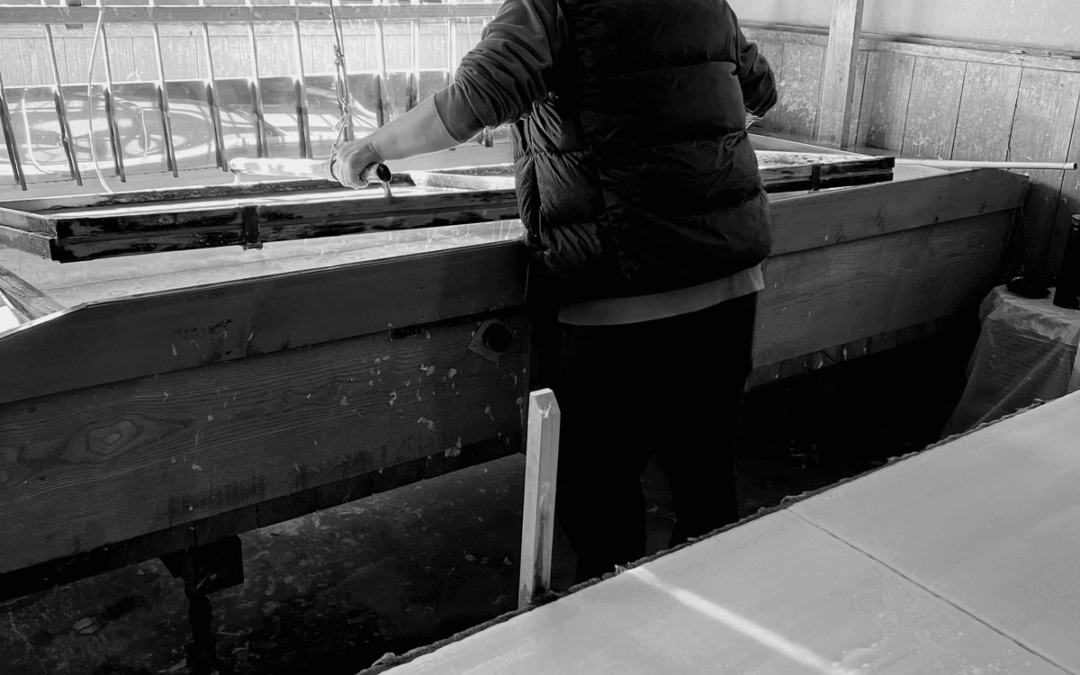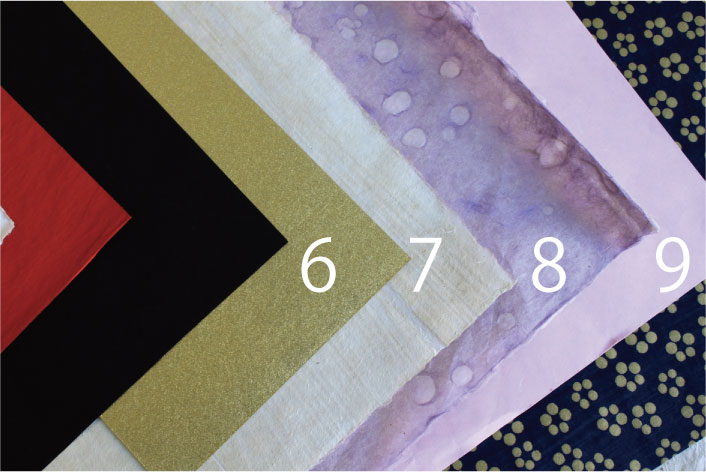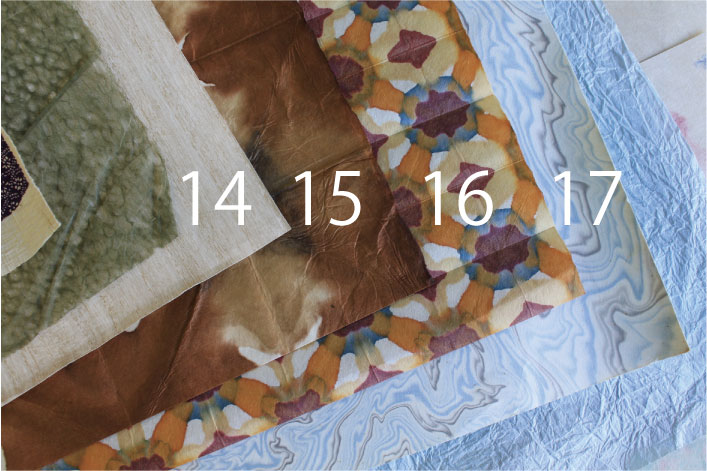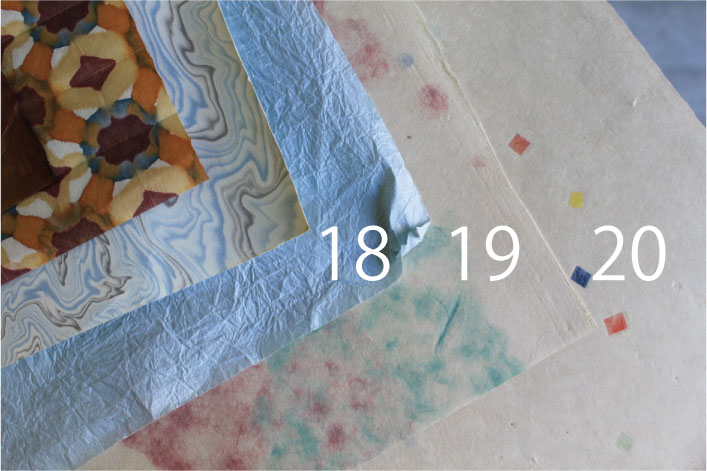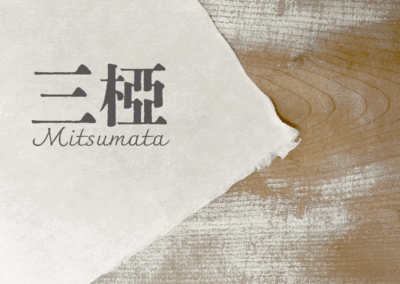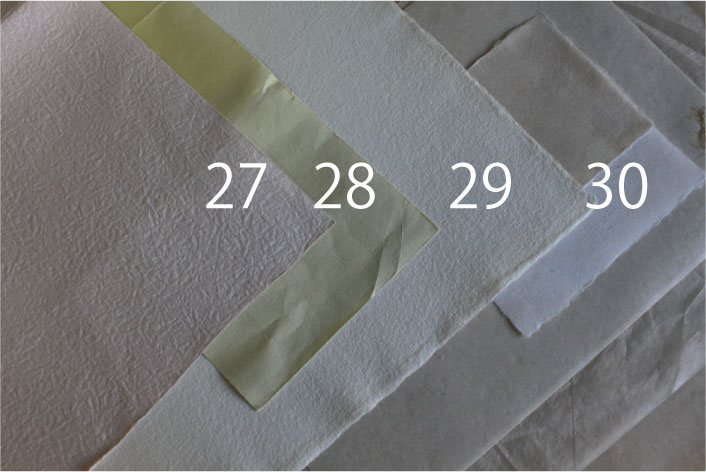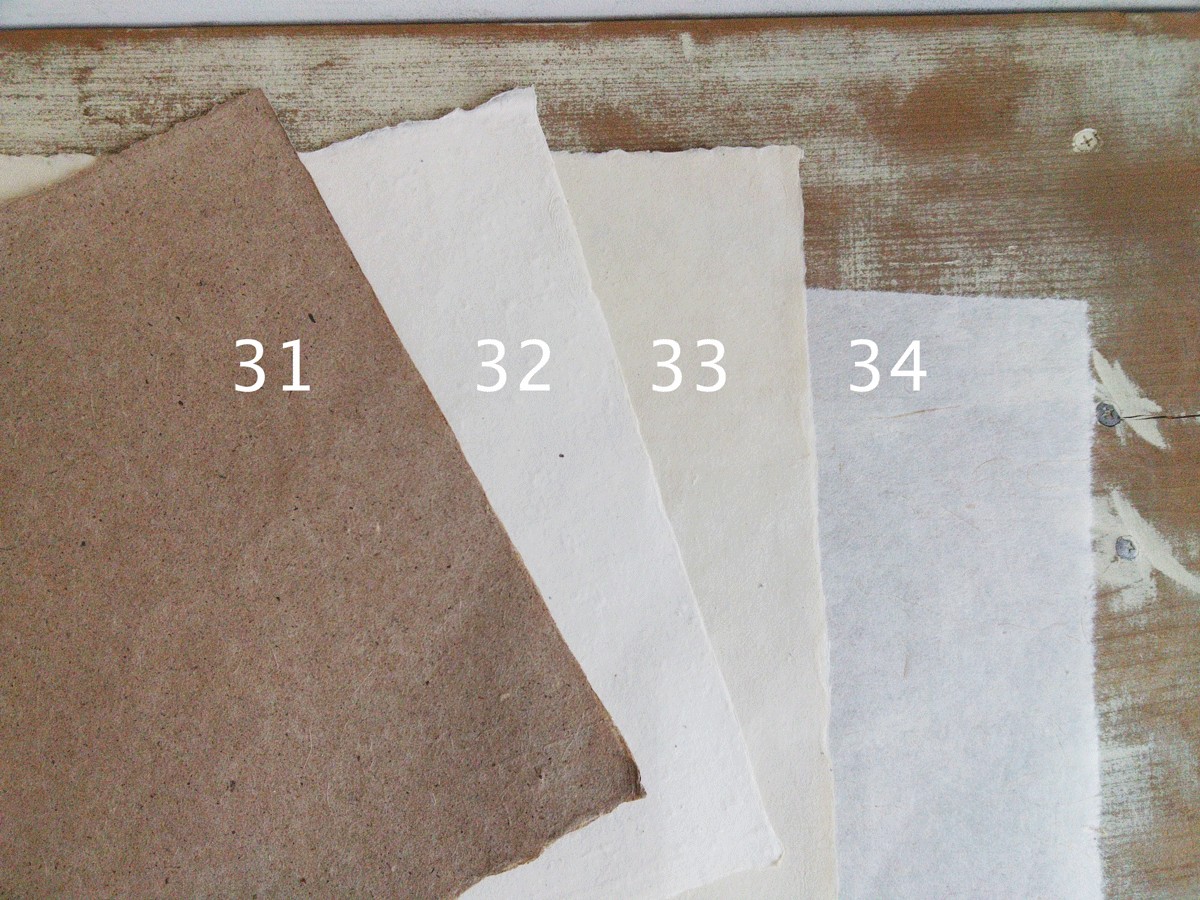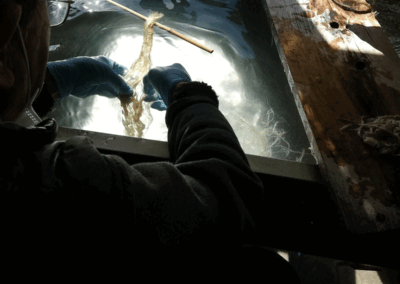Papers ~Washi~
There are various Washi in Japan. Here, We’d like to introduce typical Washi.
Color and pattern variation
Washi comes in many colors and patterns, giving each piece a unique charm.
- 1.Kakishibu zome gami
- The paper was made waterproof by dieing of Kakishibu (Persimmon tannin). It is growing deep color on exposure to air.
- 2.Chiyogami
- The wood-block printed paper. Edo-chiyo and Kyo-chiyo are the typical paper among Chiyogami.
- 3.Kamakura-bori fuu Washi
- The embossed paper resembles Kamakura-bori. ( Tradditional caved lacquer ware from Kamakura, Japan. )
- 4.Gofun Zome (Vermilion)
- The paper is painted with red colored Gofun (white pigment) , has characteristic mat texture.
- 5.Gofun Zome (Jet black)
- Black version at 4.
- 6.Kin shi
- The paper is coated by gold-colored metal powder.
- 7.Itame washi
- The paper has a woodgrain pattern, which was transferred by drying a washi on the wooden board with clear grain.
- 8.Mizu tama
- The paper has pattern made with flicked water with fingers.
- 9.Tairei-shi
- Single color, it contains shiny fibers.The paper is widely used in general such as for packaging, bookbinding and writing.
- 10.Mokuhan washi
- Woodblock printing pattern paper. Only small size (roughly A4) is available, because the woodblock printing plates are small.
- 11.cha-iri washi
- The paper includes green tea leaves. As the tea leaves are included, the paper Turns faintly green.
- 12.Chiri-men washi
- This paper resembles Chiri-men, which is Japanese silk crepe. It has characteristic soft texture like cloth.
- 13.Rakusui-shi
- This paper includes rough hemp fibers. It has many holes made by a water shower.
- 14.Kiri gami
- Kiri is paulownia wood in Japanese. Kiri gami is a thin slice of Kiri. Traditionally it has been used as materials of a chest and a box in Japan.
- 15.16. Izumo-itajimegami
- These papers are washi holded, clamped between two wooden blocks and dyed.
- 17.Suminagashi (Japanese marbling)
- Suminagashi is the Japanese paper marbling using Japanese calligraphy inc.
Plain Natural Washi
In Japan, we make Washi using mainly Kõzo, Mitsumata and Ganpi which are plants
Kōzo
:Paper mulberry, “Broussonetia kazinoki x papyrifera”
The paper made from Kõzo is the whitest, and the strongest among 3 different type of Washi, because the fiber of Kõzo is the longest among 3.
It has been grown easy, thus the most popular paper.
It is assumed that current kõzo is mixture between kajinoki and Himekõzo. There fore, kõzo is different depending on production region.
[Uses]Traditionally used for writing, but also for shoji screens, umbrellas, lanterns, and many other items that supported daily life.
Mitsumata
:Oriental paperbush,”Edgeworthia chrysantha”
Traditionally Mitsumata had reddish-brown or brown color, nowadays it became custard cream color due to different production method. Good for brush writing. It is non-native species in Japan,
It is said that Japanese Buddhist monks brought Mitsumata to Japan when they returned from China.
[Uses] Produces glossy and smooth paper, known not only for calligraphy but also as the material for Japanese banknotes.
Gampi
: Ganpi, “Diplomorpha sikokiana”
It’s smooth and translucent. The rarest material in Washi, used for luxury books. It’s very difficult to cultivate, grown only in Japan.
[Uses] Creates translucent paper, valued for kana calligraphy, painting, and also favored for copperplate printing.
- 21.Izumo-warabanshi
- Machine-made hanshi paper containing straw– Standard
- 22.Tengujō-washi
- ultra-thin, perfect for mending tears.
- 23.Mitsumata paper
- made from Mitsumata fiber.
- 24.Kozo paper
- made from Kozo fiber.
- 25.Izumo-warabanshi, Atsukuchi
- Machine-made hanshi paper containing straw- Heavyweight
- 26.Gampi paper
- made from Gampi fiber.
- 27.Torun Sheets – a functional Japanese paper
- A special Japanese paper with tourmaline and zeolite, designed for use as bed sheets.
- 28.CR paper
- A functional Japanese paper with tourmaline, zeolite, and turmeric, developed for storing kimonos.
- 29.Thick Japanese paper, machine-made
- suitable for book cores, printmaking, or watercolor.
- 30.Gettou paper postcard
- made with Shell Ginger
- 31.Ryukyu paper-Basho shi
- Okinawan traditional paper from Basho fiber
- 32.Ryukyu paper-Ryukyu Kozo shi
- Okinawan traditional paper from Okinawan Kozo fiber
- 33.Ryukyu paper- Ao gampi shi
- Okinawan traditional paper from Okinawan Blue gampi fiber
- 34.Getto shi
- Okinawan modern paper with Shell ginger fiber
Exploring Washi with Marumizu
Papermaking is said to have started long ago in China, during the Western Han dynasty (206 BC – 24 AD). From there, it spread to Korea and eventually reached Japan. Over the centuries, Japanese papermakers refined the process in search of strength and beauty, and what emerged was washi—Japanese handmade paper.
The three classic fibers for washi are kozo (paper mulberry), mitsumata, and gampi. To these, makers add a natural mucilage from the root of the tororo-aoi plant, which gives the pulp a unique stickiness. Using the nagashi-zuki (flowing sheet-forming) method, the fibers spread evenly and interlock tightly. This makes washi not only long-lasting and durable, but also wonderfully thin and light.
True, authentic washi is made by hand, using 100% natural Japanese-grown fibers. The fibers are boiled in lye, carefully separated, mixed with tororo-aoi, and then formed into sheets one by one.
Today, for reasons of efficiency and cost, many types of washi include chemical agents, wood pulp, or are mass-produced by machines. These papers are more affordable, but they differ from traditional washi in character and feel.
In Japan, washi has been more than just paper for writing or printing. It has played an important role in rituals and daily life—wrapping sweets, making dolls and bags, lining shoji windows and fusuma doors, even in currency, clothing, umbrellas, and toys. For each use, a special type of washi was created.
Washi is not just paper—it is a material that connects history, craft, and daily life in Japan.
Japan is blessed with the plants used for making washi, and each region—from Hokkaido to Okinawa—has its own special papers. At Marumizu, we love discovering and using these local treasures in our work. If you ever visit a papermaking village, take the chance to experience its history and craft.
Japanese people have long valued creating, sharing, and preserving their works—a spirit that continues today. Using quality materials helps these creations last for future generations.
Handmade washi may be costly, but its beauty, texture, and ability to enhance your work are unmatched. Whenever you can, try creating with genuine washi—it will make your work truly shine.
There are various theories about its history.
